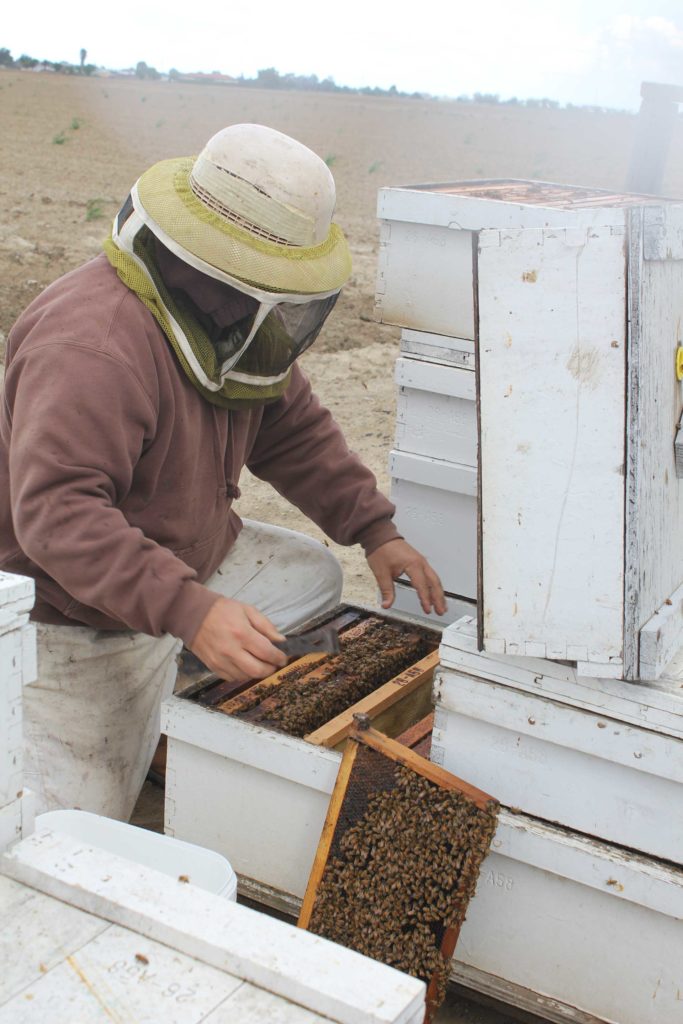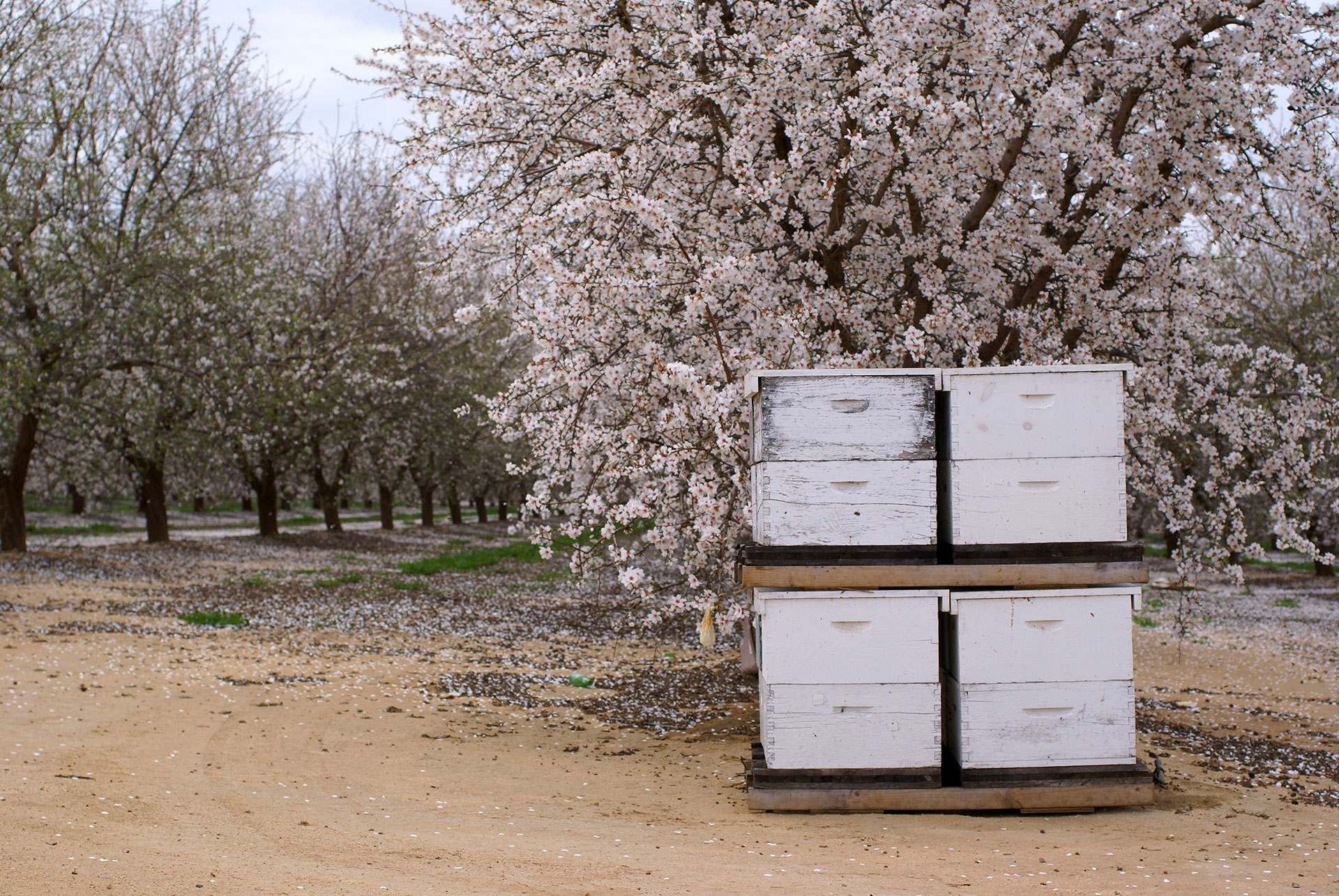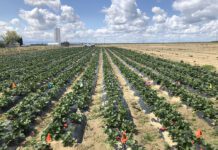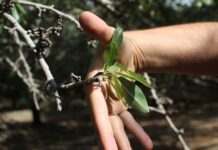Avoiding losses due to varroa mites, lack of adequate fall forage and high overwintering feeding/labor costs are all reasons California beekeepers have for considering storing their colonies indoors during the winter.
Temperature-controlled
In temperature-controlled storage, bees are less active and go into a hibernation mode. This extends the life of the bees and causes a break in reproduction as the queen does not lay eggs. Bees normally live 40-50 days, but inside, their life span can be extended to 150 days, as they are not burning themselves out feeding their young. The break in reproduction can also break the life cycle of the parasitic varroa mite, one of the leading causes of hive mortality.
Last year in Kern County, one of the first large scale storage facilities housed about 40,000 bee colonies over the winter. The controlled atmosphere building was an alternative to field storage and supplemental feeding over the winter. Inside storage isn’t new for beekeepers in cold winter climate states like Idaho, Montana and the Dakotas, but it is rare in California.
The aim with indoor or controlled atmosphere storage is to bring out strong, healthy hives for successful almond pollination. With more than one million acres of almond trees planted in California, adequate numbers of strong, healthy bees are crucial for pollination and nut set. While the almond industry has stepped up and planted 28,000 acres of bee forage since 2011 to provide nutrition before and after almond bloom, growers depend on strong hives arriving at their orchards to do the job.
Poor overwintering has a strong impact on beekeepers and almond growers because almond bloom is also when colonies are at their lowest populations and are just beginning to rebuild numbers. Weak colonies will not be able to rear enough brood to fulfill hive strength requirements needed for pollination. Lost colonies cannot be replaced in February. Colonies that have survived are the ones available for pollination.

Just the Beginning
Overwinter indoor bee storage in California is in its infancy compared to Idaho, but there is beekeeper interest—as well as a learning curve. Visalia area beekeeper Steve Godlin said a lot of beekeepers are exploring their overwintering options. Godlin said he is working on his own small facility to see what works best for his bees.
Costs to keep temperatures at a consistent level, air flow and humidity are all important factors in indoor bee storage, he said. It is not that the traditional yard storage does not work, but there are tricks to being successful.
Mild Winter Temps
Tulare County beekeeper Roger Everett said Central California’s mild winter temperatures would require bee storage facilities to be cooled. Carbon dioxide levels would need to be monitored and a back up system in place for power.
“In the Central Valley, you can’t just open the doors to exchange air and regulate temperatures like they do elsewhere. The temperature has to be at 40 degrees F consistently.”
Everett said beekeepers also need to think about the health of the hives they are placing in storage.
“You get out what you put in,” he said.
Advantages to Indoor Storage
There is an advantage to indoor storage if it reduces feeding and labor costs and bees come out strong, Everett said. Beekeepers considering indoor storage need to have a strategy for choosing which of their hives will be stored indoors.
One strategy suggested by a United States Department of Agriculture (USDA)-Agricultural Research Service (ARS) research team at the Carl Hayden Bee Research Center in Tucson, Arizona, is to select colonies to overwinter in indoor storage based on their size and varroa populations in September. A decision tool developed by the team for beekeepers showed that selecting the colonies based on their guidelines could reduce costs in preparing, transporting and overwintering hives that are unlikely to reach the size needed for pollination.
Preventing Bee Theft
Los Banos beekeeper Gene Brandi said the serious problem of robbing would not be an issue in cold storage. Weak hives in outside yards can be robbed of honey by stronger hives. Bees would not expend energy to forage for food and are also less likely to spread mites to other hives. Mites can also enter hives when foragers rob weak colonies.
Research
According to Dr. Elina L. Nino, Cooperative Extension bee specialist at UC Davis said more California beekeepers are interested in learning more about indoor storage options, but might be reluctant until there are more positive experiences.
Nino said more work needs to be done to determine the challenges with potential pest and pathogen spread between stored colonies, as well as what is the optimal environment for the stored hives and the potential effects on queens.
Nino said the research team study found that while the cost of overwintering bees was lower in cold storage, that option did not reduce overwintering losses. From their analysis, indoor storage costs less per colony than apiaries, but best management practices need to be developed to improve overwinter survival. Those include, besides colony selection:
• Optimal time for placing colonies in storage, and the amount of resources required for overwintering.
• Establishing and enhancing pollinator habitat in the summer and fall are also part of the solution.
With better forage opportunities, the study said, fat body mass and vitellogenin (female-specific egg yolk protein) levels critical for successful overwintering are enhanced when bees have access to fall pollens.
Due to California’s late spring rains this year, Brandi said fall blooms of blue curl and tarweed were especially helpful for bee health and honey production.

Cecilia Parsons
Cecilia Parsons has lived in the Central Valley community of Ducor since 1976, covering agriculture for numerous agricultural publications over the years. She has found and nurtured many wonderful and helpful contacts in the ag community, including the UCCE advisors, allowing for news coverage that focuses on the basics of food production.
She is always on the search for new ag topics that can help growers and processors in the San Joaquin Valley improve their bottom line.
In her free time, Cecilia rides her horse, Holly in ranch versatility shows and raises registered Shetland sheep which she exhibits at county and state fairs during the summer.
















